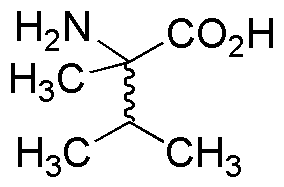a-Methyl-DL-valine is widely utilized in research focused on:
- Pharmaceutical Development: This compound serves as a building block in the synthesis of various pharmaceuticals, particularly in the development of drugs targeting metabolic disorders.
- Protein Engineering: It is used in the modification of proteins to enhance their stability and activity, making it valuable in biotechnological applications.
- Research on Amino Acid Metabolism: Scientists utilize it to study amino acid pathways, helping to understand metabolic diseases and potential treatments.
- Nutrition Science: This compound is explored in dietary supplements aimed at improving muscle recovery and growth, appealing to athletes and fitness enthusiasts.
- Biochemical Research: It is employed in various biochemical assays to investigate enzyme activity and protein interactions, providing insights into cellular functions.
Informations générales
Propriétés
Sécurité et réglementation
Applications
a-Methyl-DL-valine is widely utilized in research focused on:
- Pharmaceutical Development: This compound serves as a building block in the synthesis of various pharmaceuticals, particularly in the development of drugs targeting metabolic disorders.
- Protein Engineering: It is used in the modification of proteins to enhance their stability and activity, making it valuable in biotechnological applications.
- Research on Amino Acid Metabolism: Scientists utilize it to study amino acid pathways, helping to understand metabolic diseases and potential treatments.
- Nutrition Science: This compound is explored in dietary supplements aimed at improving muscle recovery and growth, appealing to athletes and fitness enthusiasts.
- Biochemical Research: It is employed in various biochemical assays to investigate enzyme activity and protein interactions, providing insights into cellular functions.
Documents
Fiches de données de sécurité (FDS)
La FDS fournit des informations de sécurité complètes sur la manipulation, le stockage et l’élimination du produit.
Spécifications du produit (PS)
Le PS fournit une description complète des propriétés du produit, notamment sa composition chimique, son état physique, sa pureté et les exigences de stockage. Il détaille également les plages de qualité acceptables et les applications prévues du produit.
Certificats d'analyse (COA)
Recherchez des certificats d'analyse (COA) en saisissant le numéro de lot du produit. Les numéros de lot et de lot se trouvent sur l'étiquette d'un produit, après les mots « Lot » ou « Lot de fabrication ».
Numéro de catalogue
Numéro de lot/série
Certificats d'origine (COO)
Ce certificat d'exploitation confirme le pays dans lequel le produit a été fabriqué, et détaille également les matériaux et composants utilisés et s'il est issu de sources naturelles, synthétiques ou autres sources spécifiques. Ce certificat peut être requis pour les douanes, le commerce et la conformité réglementaire.
Numéro de catalogue
Numéro de lot/série
Fiches de données de sécurité (FDS)
La FDS fournit des informations de sécurité complètes sur la manipulation, le stockage et l’élimination du produit.
DownloadSpécifications du produit (PS)
Le PS fournit une description complète des propriétés du produit, notamment sa composition chimique, son état physique, sa pureté et les exigences de stockage. Il détaille également les plages de qualité acceptables et les applications prévues du produit.
DownloadCertificats d'analyse (COA)
Recherchez des certificats d'analyse (COA) en saisissant le numéro de lot du produit. Les numéros de lot et de lot se trouvent sur l'étiquette d'un produit, après les mots « Lot » ou « Lot de fabrication ».
Numéro de catalogue
Numéro de lot/série
Certificats d'origine (COO)
Ce certificat d'exploitation confirme le pays dans lequel le produit a été fabriqué, et détaille également les matériaux et composants utilisés et s'il est issu de sources naturelles, synthétiques ou autres sources spécifiques. Ce certificat peut être requis pour les douanes, le commerce et la conformité réglementaire.


